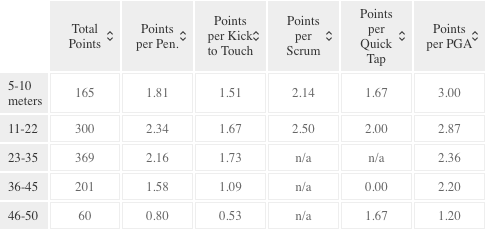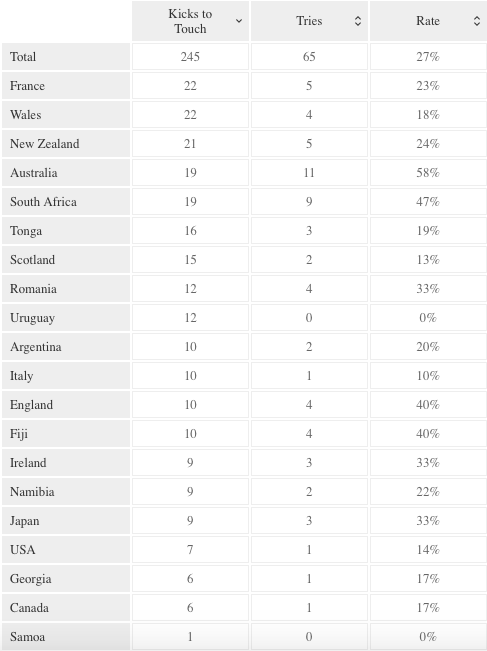
PHILADELPHIA, PA – The question of what a side should do with a penalty won in the attacking half continues to haunt me. For now, the most complete data set I have access to is from the World Cup. I’ve spent this week looking at all of the penalties from the World Cup and focused on those won in the attacking half.
You know who turned penalties won in the attacking half into tries? The team who was already winning. 69% of tries scored directly from penalties were scored by the team in the lead or at least tied. If we narrow the time frame to the last quarter of the match, from minute 60 onward, 75% of tries scored from lineouts following penalties were by the team already winning. If you are a fan of the underdog and aggressive decision making, weep.
Evaluating all decisions made from all penalties won in the attacking half, the penalty goal attempt (PGA) brought the greatest return, regardless of distance.
Here is the data for all penalties won in the attacking half.
Points scored directly come from the possession, or penalty goal attempt, immediately following the penalty.
Below is the return from different options broken down by distance to the try zone. Oddly, the penalties won 11-22 meters out had a better return than penalties won 5-10 meters out.
The data on penalties won inside of 10 meters is skewed. When teams opted for a PGA, what was recorded was the spot of the kick. Otherwise, I would have needed to record both where the penalty was given and from where the kick was taken. I chose not to do that and keep it simpler with just the one location. Therefore, some of the penalties that end up in the 11-22 range or even the 23-35 range actually occurred closer to the try line than that.
Choosing the 5 meter scrum was more likely to lead to a try than a kick to touch. This number is interesting, but we cannot ignore that only sides with confidence in their scrum chose this option. Still – if a side has a good scrum and a good lineout, the scrum is the better option according to this information.
Context and Details
At the 2015 Rugby World Cup, South Africa was the best side at turning penalties won in the attacking half into points. 37.2% of those penalties led to points either directly or indirectly. Next best was Australia at 27.3%.
Uruguay, Canada, Georgia, Namibia, and USA were all under 10% in their rate of return.
Only 2 teams who were losing in a match and opted for a scrum scored a try from that scrum. That was Romania down by 8 to Canada and Japan down by 3 to South Africa. Romania and Japan both won those matches.
In all 48 matches, no team losing by 13 points or fewer scored a try from a lineout in the last quarter of the match. Ouch.
Here is the breakdown for how teams did when they kicked to touch. Australia’s success is pretty absurd.
Clarifying Direct and Indirect Points
In the attempt to capture the full value of the decision made from a penalty, I recorded points scored directly and indirectly.
In their match against Canada, Romania won a penalty 5 meters out. They kicked to touch. From the lineout they won another penalty. They opted to scrum. They won another penalty from the scrum and elected to scrum again. From that scrum, they scored a try which was converted. Romania scored no direct points from the first 2 penalties; however, the try they scored was connected to the original decision. In my accounting, 1 penalty, the last, directly led to points (5 – the 2 points for conversion are counted as indirect). The other two penalties indirectly led to points (7 each). When all of the indirect points are tallied, though, that try is counted twice, which is why it has been difficult for me to include delayed results as part of the points per decision math.
The try and the conversion are two distinct acts whose success are linked to largely distinct skills. For that reason, only the 5 points from the try were counted as direct points. The conversion is a consequence but is separate, so those points were counted as indirect.
This accounting of the conversion seems like maybe something that might be changed in the future.
I was hoping these numbers might help me see what a losing team should do with a penalty in the second half. What they showed, unsurprisringly, was that the team good enough to get ahead was good enough to win.
As I watch other matches, I will assume that all competitions will include matches in which one side is heavily favored over the other. Let us also assume that all competitions include incentives for scoring tries and for losing by a limited margin. With these assumptions, the World Cup is not special and we can act like the decision making process in these matches is similar to the decision making processes in other competitions.
Those are big assumptions, but until the data show they are wrong, I am going to roll with them.
That’s it… Feel free to comment below, look for and “Like” our Facebook Rugby Wrap Up Page and follow us on Twitter@: RugbyWrapUp, Jake Frechette, Junoir Blaber, James Harrington, Jamie Wall, Nick Hall, DJ Eberle, Scheenagh Harrington, Jamie Loyd, Cody Kuxmann, Karen Ritter, Audrey Youn, Akweley Okine, Rocky Brown and Declan Yeats, respectively.



